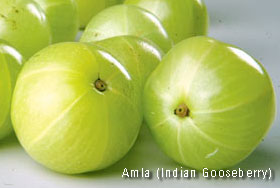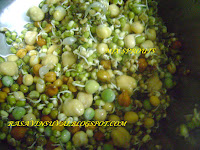Amla (Emblic Myrobalans) Therapy
Botanically called
Phyllanthus emblica, syn.
Emblica officinalis , (
Indian gooseberry) it
is a rich source of vitamin C, amino acid, tannin, polyphenolic
compounds, fixed oil, lipids and other essential oils. It may be
compared with ‘Amrita’ (nectar) of the heavens owing to the medicinal
qualities of this divine fruit. Its regular consumption is an anti-dote
for many ailments/disorders like acidity, septic fever, biliary colic,
vomiting,
insomnia, defective vision etc.
Amla tree is found in all parts of India. It is generally 20-30 ft.
high. Its bark is rough and brownish in colour. It has regular branches,
bluish yellow flowers, small leaves like that of the Imli (tamarind)
tree. Its fruit is round and greenish yellow in colour with six segments
and a hard seed inside. Among all the varieties that are available, the
best is Kalami for its fruit has lot of pulp, very small seed and is
comparatively less sour and bitter in taste than others. It is
especially good for making jams, pickles, chutneys etc. Chyavanprash is
also made from Amla only.
Perhaps owing to its medicinal qualities the Hindus treat it as a
very sacred tree and worship on ‘Akshaya Navami’. In the Kartik month
(mid Oct. to mid Nov.) if one takes its dose regularly it provides
complete protection against all the disorders due to cold. Amla is
unique as it doesn’t leave its chemical ingredient even if it is heated.
It is a tree whose no part is useless. It also has the atmosphere
purifying qualities. Chemically, besides being the best source to get
Vitamin C from, it also has gallic acid, tannic acid, sugar, albumen,
calcium, protein, phosphorus, carbohydrates, irons etc.
Amla as general tonic

Taking Amla and Black Til (black seseme seeds) in equal quantity with honey or ghee cures mental and physical weaknesses.
To revitalise brain take a cupful of sugarless milk with the murabba of Amla.
Taking even one raw Amla every morning even with water makes one’s body enough resistance to fight with various ailments.
Taking milk in the morning after licking one teaspoon of ground Amla powder mixed with
honey
imparts freshness and strength to the body. Intellect get sharpened if
one takes the pulp of fresh Amla or Amla juice with honey or ghee every
morning and evening.
As an eye tonic and cure of eye ailments
Washing eyes with cool water having Amla powder soaked and strained is good for the eyes and it also improves eye-sight.
Washing the eyes with ground Amla and til powder water (soak Amla and
Til powder in water overnight and strain it) in the morning cures
burning sensation in the eyes.
Applying pulp of Amla on the head and washing the hair after
massage helps in curing burning sensation in the eyes and heaviness of the head. (
See also :
Remedies for premature greying of hair)
Have Amla powder washed down with milk to improve your eyesight.
Eating 10 gms. of Triphala (the powder made by mixing even quantity
of Hirda, Bahera (Behda) , Amla powders) with 1 tsp of honey keeps eyes
very healthy strong and sparkling.
Having Triphala powder with honey not only keeps eyes bright and shining but it is also very good for the digestive system.
For curing head and heart ailments
Taking Amla Murabba every day in the morning cures physical and
mental debility. Taking Amla juice is ideal for keeping your head and
eyes strong.
Massaging the scalp with Amla oil before going to bed removes mental weakness.
Taking Amla powder with cow’s milk or Misri (even amount) with water gives relief in heart ailments.
Applying paste made up of dried Amla powder with Kumkum, Neelkamal
and rose-water cures headache. Applying paste of Juice of 2 to 3 Amla or
its pulp mixed with little rose water and 3 to 4 pieces of kesar
(saffron) in it-on the affected part for 15 mts. relieves the pain of
migraine.
Curing involuntary nocturnal emission
Taking 10 gms of fresh Amla juice with 1 gm. of powdered haldi
(turmeric) and honey every morning and evening cuers this problem. (
See also :
health benefits of turmeric )
Taking Amla water (soak dried Amla powder in 1:3 proportion in water
for 12 hours, strain the water and mix 1 gm. haldi powder) regularly
helps in curing night discharge problem. (
See also : Remedies for Sexual Impotence)
Problems connected with uro generative system
Taking 1 gm Amla powder, kala jeera and 2 gms. ground misri with cold water cures the problem of bed wetting.
Taking milk after eating fresh Amla juice or dried Amla powder with gur (jaggery) cures stranguary.
Applying paste of Amla near the naval portion helps in curing
urinary problem.
Boil 20 gm. pulp of dried Amla in 160 gms. water till 40 gms. is left.
Then mix 20 gms. of Gur (Jaggary) in it. Drinking this potion helps in
urinary problem.
Taking crushed Amla pulp (after straining it) mixed with misri cures blood in urine.
Taking 20 gms fresh Amla Juice with 10 gms. of honey and water twice a day cures problem connected with urination.
Acidity and digestive problems
Licking one tea spoon of dried Amla powder with honey or ghee after dinner checks acidity. (See also :
Remedies for acid peptic ulcers)
Female ailments
Taking 3 gms. powdered Amla with 6 gms. honey every day for one mouth cures the problem of leucorrhoea.
Leucorrhoea is also cured by taking powder of Amla seed with honey or
mjsri regularly. Taking 20 gms. fresh Amla juice mixed with honey
regularly for a month cures weakness of the generative system.
Blood impurities
Taking Amla juice or powder with honey purifies blood.
Taking 5 gms. of powder (made from 20 gms triphala, 20 gms. black
pepper, 10 gms. pure sulphur, 5 gms. of neem leaves and mehandi
leaves-ground in fine powder form) with a glass of water twice a day
cures all impurities of blood.
Diabetes
Taking fresh Amla juice with honey checks
diabetes.
Piles
Soak 15 gms. Amla and 15 gms. of mehandi (myrtle) leaves overnight in
400 gms. water strain the liquid in the morning. Drinking this water
checks piles. Taking 5 gms. of triphala churna with a glass of whey
helps in curing piles. Also, taking fresh Amla juice with half tsp of
ghee and 1 tsp. of honey and 100 gms. of milk-after lunch-cures even
chronic
piles problem.
Stone-problem
Taking Amla powder with radish helps in checking stone in bladder by
breaking the stones and throwing it out with urine. The best time to
have them is morning or evening.
Constipation
Have 1 tsp dried Amla powder with milk or water before retiring for
the day. It helps in imparting movements to the bowels and keeping the
system clean. Also taking strained water of mashed fresh Amlas soaked
overnight in lukewarm water helps in evacuating the bowels. Taking 4 tsp
fresh Amla juice and 3 tsp honey mixed in a glass of water relieves
constipation. If constipation is caused by worms, take about 20 gms. fresh juice of Amla every day to kill the worms.
Cold and cough
Taking two tsp of fresh Amla juice with honey twice a day helps in taking out the phlegm and controls
cold.
Also, taking milk in which a little Amla powder and ghee boiled in the
evening helps in dry cough. Licking Amla powder with honey regularly
twice or thrice a day also cures chronic dry
cough.
Skin troubles
If there is the problem of extreme dryness of the skin, taking tea
boiled with pieces of Amla in it mixed with sugar and milk helps
greatly. Itching problem is cured by applying Amla churna in chameli oil
(dry Amlas in shade, powder them and mix them in chameli-Jasmine oil.
The bottle should be kept in shade) on the part of the body where
itching is gives reting. (
See also :
Remedies for Acne)
Baldness and other allied problems
Washing the head with Amla-juice mixed with water after rubbing the
scalp for 10-15 mts. with fresh Amla juice helps in restoring the
vitality of hair. Soak dried Amla, Harar, Bahera and Shikakai in an iron
utensil overnight and mesh them nicely, washing your hair regularly
with this strengthens the hair and checks
hair loss.
Applying the paste of Amla powder mixed in
lemon juice on the hair 10 to 15 mts. before washing them with Amla water keeps the hair strong and shining.
Dying the hair with the following herbal paste makes them turn
automatically black and strong. Make the paste of Amla and Mehandi
leaves and apply it on the hair. Keep it applied for about 15 to 20 mts.
Then wash it off with lukewarm water. This will make your hair black
and shining.
Washing the hair with dicoction of Amla removes dryness of the scalp, checks dandruff and stops
excessive fall and the
greying of hair.
Massaging the head with Amla oil imparts natural glow to hair, relieves mental tension and induces sleep.
Jaundice
Soak 4 Munnakkas (big raisins) in juice of 4 fresh Amla. After one
hour grind the soaked munakkas and mix it with Amlajuice. Taking this
potion twice a day gives relief in
Jaundice.
Mix a churna in the following way. Grind each of Amla, dry ginger (Read more on
health benefits of ginger), black pepper, 3 gms. of iron bhasm and little turmeric. Lick this churna mixed with a teaspoonful
honey helps cure Jaundice.
Gout
Taking fresh Amlajuice with old ghee-heated a little-regularly for a few says relieves stiffness of joints and helps in curing
gout.
Removing the spots left by measels, chicken pox, small-pox etc.
Take bath with the water having Amla juice mixed in it. Also, apply
the paste made of Amla and til in equal quantity ground in cold milk
added with 3 or 4 drops of rose water on spots and let it stay for
sometime and then wash it off with Amla soaked water.
Boils in mouth
Doing gargles with water having fresh Amla juice twice or thrice a
day gives great relief and helps curing the boils. After gargles apply
fresh Amla juice on the boils and let saliva ooze out.
Lices in hair
Applying the paste of ground seeds of Amla mixed with lemon-
especially on the roots of the hair and washing after half an hour will
clear the lices from the hair. Even when washing it off use the water
having little of Amla juice.
Amla as the beautifying agent
Application of the Amla paste mixed with turmeric and-oil on- body makes the skin clear, soft and improves the complexion.
Drinking Amla juice mixed with honey in the morning makes the complexion glowing and blemishless.
Application of the Amla paste on the face and washing it off after 10 to 15 mts class pimples and heals up the spots so created.
Checking menstrual disorder
Take boiled pulp of Amla with honey two times a day relieves the pain in the bleeding.
Taking Amla juice mixed with ripe banana 3 to 4 times a day during periods-checks profuse bleeding.
Insect-bite
Applying the paste made of Triphala powder mixed with cow’s urine-on
the affected part-relieves the poisonous effects of insects. Drinking
Amla juice will also help in such cases.
General maintenance of health
Munching raw Amla or one piece of Amla Murabba washed down with milk
is an ideal breakfast for staying healthy and living till ripe old age.
Also, taking Chyavanprash (having enough of Amla) in the morning is also very good tonic for maintaining good health.
Taking sharbat of Amla in summers keeps the body cool even in the height of summers.














